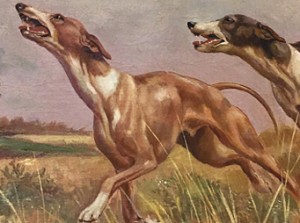The Glorious Art of the Coursing Greyhound
242 – May 2017
by Debra Lampert-Rudman
“I see you stand like greyhounds in the slips, Straining upon the start. The game’s afoot; Follow your spirit: and upon this charge, Cry — God for Harry! England and Saint George!” – William Shakespeare, Henry V
 Throughout the ages, due to its inherent elegance, grace and beauty, the Greyhound has been depicted in prized art and decor from paintings and porcelain sculptures to bronzes, ivory whistles and even carved heads on walking sticks.
Throughout the ages, due to its inherent elegance, grace and beauty, the Greyhound has been depicted in prized art and decor from paintings and porcelain sculptures to bronzes, ivory whistles and even carved heads on walking sticks.
In fact, when you think of the late 19th and early 20th cen- turies – particularly the Art Deco era – 1920s and 1930s – one of the iconic images that comes to mind is that of a glamorous woman with her gorgeous greyhound by her side.
But, perhaps the most frequently and beloved depictions, on canvas or in clay, are of Greyhounds as celebrated working dogs. The Coursing Greyhound caught in full, reaching stride; powerful, sleek-bodied and most times set in a British Coursing field, seen chasing a hare or at the successful hunt’s end. Some particularly exciting examples include “Coursing Greyhounds,” an oil painting attributed to Gustav Muss-Arnolt, full of action in a field with flying dogs and hares; Phillip Stretton’s “Grey- hound in a Landscape,” portrait from 1902, F. Harnal’s bronze “Coursing”, and Jacob Petit’s delicate porcelain “Greyhound with Dead Rabbit”
This type of portraiture wasn’t just popular because of the breed’s inherent beauty alone. In fact, in the 1800s Greyhound Coursing was as eagerly followed as horse racing and the “stars” of the Coursing track just as highly-prized.
Coursing and the Landed Gentry
The true sportsman does not take out his dogs to destroy the hares, but for the sake of the course and the contest between the dogs and the hares, and is glad if the hare escapes.
- Flavius Arrianus, 116 AD
Records of formal hare coursing were documented as early as 116 AD, however the first modern club was established in the United Kingdom at Swaffham in Norfolk in 1776, according to David Brian Plummer’s ROGUES AND RUNNING DOGS, by Lord Orford – a fancier known for refining the Greyhounds’ ear carriage and coat – and the National Coursing Club was formed in 1858. In 1882, the NCC created the original Greyhound Stud Book, which it has administered ever since. Accord- ing to the group’s website, from that date the breed was “closed”; all greyhounds running today on track and field trace back to those original dogs.
Click here to read the complete article242 – May 2017
Short URL: https://caninechronicle.com/?p=125275
Comments are closed











